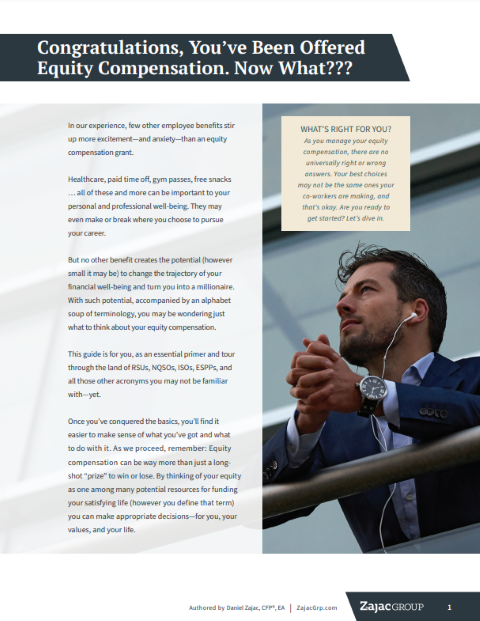An employee stock purchase plan, or ESPP, can provide employees of a company a vehicle through which to purchase that company’s stock.
This is usually done through automated payroll deductions, which makes the system convenient, and employers may offer added benefits like discounts on the market price of the shares and a lookback provision.
These two features alone may make it seem like a no-brainer to participate in an ESPP if you can. It’s another way to add to your compensation outside of your regular income. But while buying into shares tends to be relatively easy, selling those you own in the ESPP is another story.
When you sell your ESPP shares, you create a reportable tax event — and this is where things may get complicated.
A good strategy for participating in an ESPP is one that not only evaluates when to enroll, how much of your pay to contribute to it, and when to sell the shares you buy but also understands the intricacies of ESPP tax rules and how they impact the after-income tax proceeds that you receive.
ESPP Tax Rules You Should Know
When you enroll, contribute, and/or purchase shares in an employee stock purchase plan, you don’t owe additional income tax from these actions. Only when you sell your shares will you encounter a reportable tax event. You usually use a few documents to do that reporting, including Form 3922 and Form 1099-B.
GET THIS GUIDE
When it comes to your finances, it's important to understand what you have, what you should consider, and how it can impact your personal goals. This guide is the best place to start.
Exactly how the proceeds of your sold ESPP shares are taxed, however, may be subject to several factors. Some of the primary determinants are whether your ESPP is a qualified plan or a non-qualified plan and if your ESPP offers a discount on the purchase price.
ESPP tax rules are also influenced by the price of your shares on several key dates. The dates where the price matters are:
- The offering date
- The purchase date (for which you’ll want to know the market price and any discount on that price you received)
- The sale date
The timeline and dates for these events lead to one of two possible scenarios: a qualifying disposition, or a disqualifying disposition.
ESPP Tax Rules for a Qualifying Disposition
A qualifying disposition (QD) occurs when you sell your shares at least 1 year from the purchase date and at least 2 years from the ESPP offering date.
According to ESPP tax rules, you may be subject to ordinary income tax and/or long-term capital gains (loss) tax if you trigger a qualifying disposition. The rules say that you will pay ordinary income tax on the lesser of:
- The discount offered based on the offering date price, or
- The gain between the actual purchase price and the final sale price. You will pay long-term capital gains on the gain in excess of the discount received, if any.
The allure of qualifying for long-term capital gains may be attractive (because they’re usually lower than your ordinary income tax rate), but this strategy requires you to hold your shares for at least 1 year after you purchase them. That may expose you to concentration and single stock risk.
Holding a single stock may leave you vulnerable to a level of price volatility in your shares that you may or may not be comfortable maintaining — or that you may or may not want to maintain if that position represents far too much of your net worth to risk.
ESPP Tax Rules for Disqualifying Dispositions
If you don’t meet the holding period requirements for a qualifying disposition, then by default you end up with a disqualifying disposition (DD).
ESPP tax rules dictate that you may be subject to ordinary income tax and capital gain/loss tax (short term or long term) on the profit/loss in this situation.
That means you will ordinary income tax on the difference between the actual purchase price and the purchase date price, and you’ll pay capital gain (loss) tax rates at the difference between the purchase date price and the final sales price (subject to short-term or long-term holding period requirements).
While paying ordinary income tax may seem less attractive than the qualifying disposition alternative, a disqualifying disposition may allow you to eliminate single stock risk, reap the proceeds of the sale, and use the money for personal consumption or other long-term savings goals.
How Your ESPP Is Taxed in a Hypothetical Example
ESPP tax rules can be complicated for many reasons, and the nuance of each situation can lead to confusion. To help further explain how your ESPP is taxed and the implications for both a qualifying and disqualifying disposition, it helps to create a hypothetical illustration.
Let’s assume the following:
- You have a qualified ESPP
- You get a lookback period that allows you to purchase ESPP shares at the better of the purchase date price or the offer price
- You receive a 15% discount on the market value of the stock at the time you purchase
- The offering price of your shares is $10
The final sale price will change the outcomes, even with all the above factors being the same across different scenarios. Specifically, we will evaluate the following scenarios: a final sale price of $50.00, then $9.50, and then $5.00 per share.
These prices lead us to the following three outcomes we will illustrate:
- Final Sales Price > Actual Purchase Price and > Offer Price
- Final Sales Price > Actual Purchase Price and < Offer Price
- Final Sales Price < Actual Purchase Price and < Offer Price
How an ESPP Is Taxed When the Purchase Date Price Is Greater Than the Offering Price
Assume that the purchase date price of the stock is $25 per share. Let’s put this, along with our other key assumption into the chart below, and calculate the profit/loss from the sale of ESPP shares:
| Profit/Loss Chart | $50.00/share | $9.50/share | $5.00/share |
| Offering Price | $10.00 | $10.00 | $10.00 |
| Purchase Date Price | $25.00 | $25.00 | $25.00 |
| Actual Purchase Price (with discount) | $8.50 | $8.50 | $8.50 |
| Final Sale Price | $50.00 | $9.50 | $5.00 |
| Taxable Profit (loss) | $41.50 | $1.00 | ($3.50) |
As you would expect, each scenario produces a different profit/loss outcome. As a next step, we can take the calculated profit/loss and model how the ESPP shares are taxed.
For a qualifying disposition, some of the ESPP proceeds may be taxed as ordinary income and some as long-term capital gains. Going back to the ESPP tax rules stated above, we know the following:
- You pay ordinary income tax on the lesser of (1) the discount offered based on the offering date price or (2) the gain between the actual purchase price and the final sale price.
- You can pay long-term capital gains on the gain in excess of the discount received, if any.
We can chart the following:
| Qualifying Disposition | $50.00/share | $9.50/share | $5.00/share |
| Total Profit | $41.50 | $1.00 | ($3.50) |
| Ordinary income | $1.50 | $1.00 | $0.00 |
| Long Term Capital Gain/Loss | $40.00 | $0.00 | ($3.50) |
For a disqualifying disposition, ESPP tax rules are different. Here’s what we know:
- The difference between the actual price paid for the shares and the purchase date price is subject to ordinary income tax rates.
- Whether you have a capital gain or loss is subject to the difference between the purchase date price and the final sales price.
Following these rules, the tax reporting is:
| Disqualifying | $50.00/share | $9.50/share | $5.00/share |
| Total Profit | $41.50 | $1.00 | ($3.50) |
| Ordinary income | $16.50 | $16.50 | $16.50 |
| Capital Gain/Loss * | $25.00 | ($15.50) | ($20.00) |
*Subject to short/long term holding period requirements
How an ESPP Is Taxed When the Purchase Date Price Is Less Than the Offering Price
In addition to exploring a scenario where the purchase date price is greater than the offering date price, it makes sense to consider the alternative: a scenario where the purchase date price is less than the offering date price.
Keeping all else constant, let’s explore the same example with a purchase date price of $8.00 per share.
If we update the chart accordingly, we see the following:
| Profit/Loss Chart | $50.00/share | $9.50/share | $5.00/share |
| Offering Price | $10.00 | $10.00 | $10.00 |
| Purchase Date Price | $8.00 | $8.00 | $8.00 |
| Actual Purchase Price (with discount) | $6.80 | $6.80 | $6.80 |
| Final Sales Price | $50.00 | $9.50 | $5.00 |
| Taxable Profit (loss) | $43.20 | $2.70 | ($1.80) |
We can then model the tax implications. For a qualifying disposition, the income tax reporting is as follows:
| Qualifying | $50.00/share | $9.50/share | $5.00/share |
| Total Profit | $43.20 | $2.70 | ($1.80) |
| Ordinary income | $1.50 | $1.50 | $0.00 |
| Long Term Capital Gain/Loss | $41.70 | $1.20 | ($1.80) |
For a disqualifying disposition, income tax reporting looks slightly different:
| Disqualifying | $50.00/share | $9.50/share | $5.00/share |
| Total Profit | $43.20 | $2.70 | ($1.80) |
| Ordinary income | $1.20 | $1.20 | $1.20 |
| Capital Gain/Loss * | $42.00 | $1.50 | ($3.00) |
How ESPP Tax Rules Impact the Proceeds You Receive from Selling Shares
You need to understand the ESPP tax rules themselves — but it’s just as important that you know how to determine what the after-tax proceeds of your ESPP participation may be. The after-tax amount is the money that you can actually use to do the things you want to do.
To calculate after-tax proceeds, we can easily apply an assumed tax rate to the ordinary income and capital gains portion of the proceeds. We can then subtract the taxes due from the gross sale proceeds to obtain our after-tax proceeds.
In our example, we will assume the following tax rates:
- Ordinary income tax rate: 32%
- Long-term capital gain tax rate: 15%
After applying these tax rates to the charts above and adding information for the final sale price of the stock, we can calculate the total after-tax proceeds of each transaction. Next, we can sort the results into a table to determine which scenarios, if any, produce the greatest amount of after-tax proceeds:
| Case Number | Actual Price Paid | Type | Sale Price | Profit | Ordinary Income | LTCG | Total Tax | After-Tax Proceeds |
| 1 | 8.5 | QD | 50 | $41.50 | $1.50 | $40.00 | $6.48 | $43.52 |
| 2 | 6.8 | DD | 50 | $43.20 | $1.20 | $42.00 | $6.68 | $43.32 |
| 3 | 6.8 | QD | 50 | $43.20 | $1.50 | $41.70 | $6.74 | $43.27 |
| 4 | 8.5 | DD | 50 | $41.50 | $16.50 | $25.00 | $9.03 | $40.97 |
| 5 | 8.5 | QD | 9.5 | $1.00 | $1.00 | $0.00 | $0.32 | $9.18 |
| 6 | 6.8 | DD | 9.5 | $2.70 | $1.20 | $1.50 | $0.61 | $8.89 |
| 7 | 6.8 | QD | 9.5 | $2.70 | $1.50 | $1.20 | $0.66 | $8.84 |
| 8 | 8.5 | DD | 9.5 | $1.00 | $16.50 | ($15.50) | $2.96 | $6.55 |
| 9 | 8.5 | QD | 5 | ($3.50) | $0.00 | ($3.50) | ($0.53) | $5.53 |
| 10 | 6.8 | QD | 5 | ($1.80) | $0.00 | ($1.80) | ($0.27) | $5.27 |
| 11 | 6.8 | DD | 5 | ($1.80) | $1.20 | ($3.00) | ($0.07) | $5.07 |
| 12 | 8.5 | DD | 5 | ($3.50) | $16.50 | ($20.00) | $2.28 | $2.72 |
From this sorted chart, it’s clear that the final sales price has the greatest impact on your after-tax proceeds. In all scenarios, with all else being equal, a higher sales price will most often lead to a higher after-tax value.
But note that in scenarios where the final sales price is the same, it is not always the case that qualifying disposition (and its presumably better tax rates) is better than a disqualifying disposition (with its tax rates that may appear less attractive at first).
We can see this illustrated when comparing case 2 and case 3, both of which have the same purchase price and final sales price. In this example, case 2 (a disqualifying disposition) produces a higher after-tax outcome than case 3 (a qualifying disposition).
Moving further down the chart, we can see the same when comparing case 6 and case 7.
And when looking at a net loss scenario, in cases 9-12, we can see that a qualifying disposition appears to be preferred as compared to a disqualifying disposition.
What Does This Mean for You (and Your ESPP)?
A good ESPP can provide you with a way to purchase company stock at an attractive price. But using an ESPP wisely is not as easy as simply participating in it.
You need to understand the ESPP tax rules and how they can impact how much money you end up keeping in your pocket if and when you sell the shares in your plan. Don’t simply assume one strategy for selling will always produce the best result for you.
Just because a qualifying disposition may appear to offer a lower tax rate, we’ve seen from our examples that this isn’t always the case. Things get complicated depending on the final sale price of your shares.
Each case is different, and you should do your own due diligence on each ESPP purchase that you have – then use that information to determine what the best strategy for each may be.
If you aren’t able to make that determination yourself, the use of a good CFP® professional and/or accountant may be the right way to go.
This material is intended for informational/educational purposes only and should not be construed as investment, tax, or legal advice, a solicitation, or a recommendation to buy or sell any security or investment product. Hypothetical examples contained herein are for illustrative purposes only and do not reflect, nor attempt to predict, actual results of any investment. The information contained herein is taken from sources believed to be reliable, however accuracy or completeness cannot be guaranteed. Please contact your financial, tax, and legal professionals for more information specific to your situation. Investments are subject to risk, including the loss of principal. Because investment return and principal value fluctuate, shares may be worth more or less than their original value. Some investments are not suitable for all investors, and there is no guarantee that any investing goal will be met. Past performance is no guarantee of future results. Talk to your financial advisor before making any investing decisions.













Daniel, you have several errors.
You show a capital gain of $20.00, when the correct result is $25.00 for disqualifying disposition, offering price $10, purchase date price $25, actual price with discount $8.50, final sale price $50, and taxable profit $41.50. The ordinary income + capital gain/loss always equals total profit. You have ordinary income of $16.50 (correct) capital gain of $20.00 (incorrect) and total profit of $41.50 (correct).
You show ordinary income is $1.50, when the correct result is $1.20 for qualifying disposition, offering price $10, purchase date price $8, actual price with discount $6.80, final sale price $50, and taxable profit $43.20. The difference between $8 and the discount, $6.80, is $1.20. You have the same mistake in the table for the final sale price of $9.50 a share. Fixing these will also change the long term capital gain.
Propagate these 3 fixes to your 12 row table and you’ll see your conclusions are not correct. There is no scenario in which a disqualified disposition generates more after-tax proceeds than a qualified disposition. There is a scenario where the two are equal. That is the case where the share price fell during the offering period from $10 to $8.
Otherwise, a complete article with all scenarios, which I have not found anywhere else.
I am not following your terminology as related to what you call the purchase date price. In your first model I understand the $50 per share and the offering price of shares at $10 and the discount price (after the 15% off) of $8.50. I understand the profit/loss amounts but can’t figure out what the purchase date price of $25 or why it is relevant. Our company does not use the purchase date price just the offer price and discounted price so not sure what the $25 is this example. Thanks
Hi Artie
The purchase date price, in my example, is important for disqualified dispositions, as it helps determine the amount of proceeds that may be included as ordinary income.
Because the example that you referred to is a qualified sale, that purchase date price is not necessary for that specific calculation.
To complete the examples, what happens when you donate the shares instead of sell them? Do you still have the ordinary income component to report and pay taxes on, or does that go away with the donation?
Hi Steve
If you have qualifying shares, you will still need to claim ordinary income on the discount.
If you are thinking about donating shares, and have other share types too (ESPP, ISO, NSO, etc), there may besome planning opportunities based on the type of shares you have, the basis, and the holding periods.
If you donate qualifying ESPP shares to a charity, do you still avoid the capital gains on the appreciation of the shares? (Meaning are you only responsible to pay taxes on the ordinary income you realized which is the difference between the offering price and the purchase price, and not on the difference between the offering price and the FMV at the time that the stock was donated)
Hi Derek
Yes, in this scenario, it seems to me the ordinary income portion would be taxable to you since it was qualified, and the capital gain would not (assuming the shares are donated to the charity, or possibly a donor-advised fund).
It may be prudent to compare the cost basis of all the shares that you have, from all sources, and see what is the “best” one to give.
I need some guidance on how to calculate taxable income. My ESPP program calculates the option price using the average of the beginning and ending offering period FMV prices, then adding a 5% discount. In a declining market, the purchase price ends up being greater than the purchase date FMV price. Would this create negative ordinary income with a disqualifying disposition?
When the purchase date price is less than the offering price, your example for a qualifying disposition has $1.50 as ordinary income when final sale price is $50 and $9.50. Where does the $1.50 come from?
Hi
In this example, the $1.50 is calculated as the potential discount received (15%) on the offering date ($10) – which equals $1.50
Hello & Season’s Greetings!
Could capital gains from an ESPP sale be offset using an individual/personal 0% capital gains allowance, therefore potentially reducing the tax liability to just the ordinary income component?
Hi Jay – Season’s greetings to you as well!
Yes, it’s possible. Capital gains would be reported on the tax return, subject to the appropriate tax rate (0%, 15%, 20% in 2020).